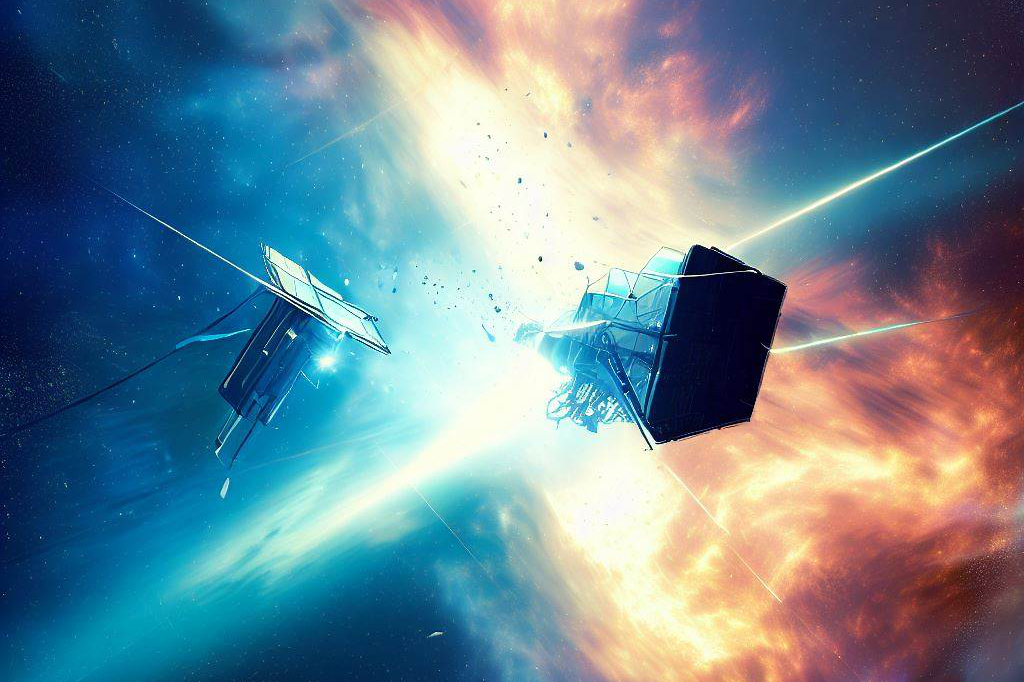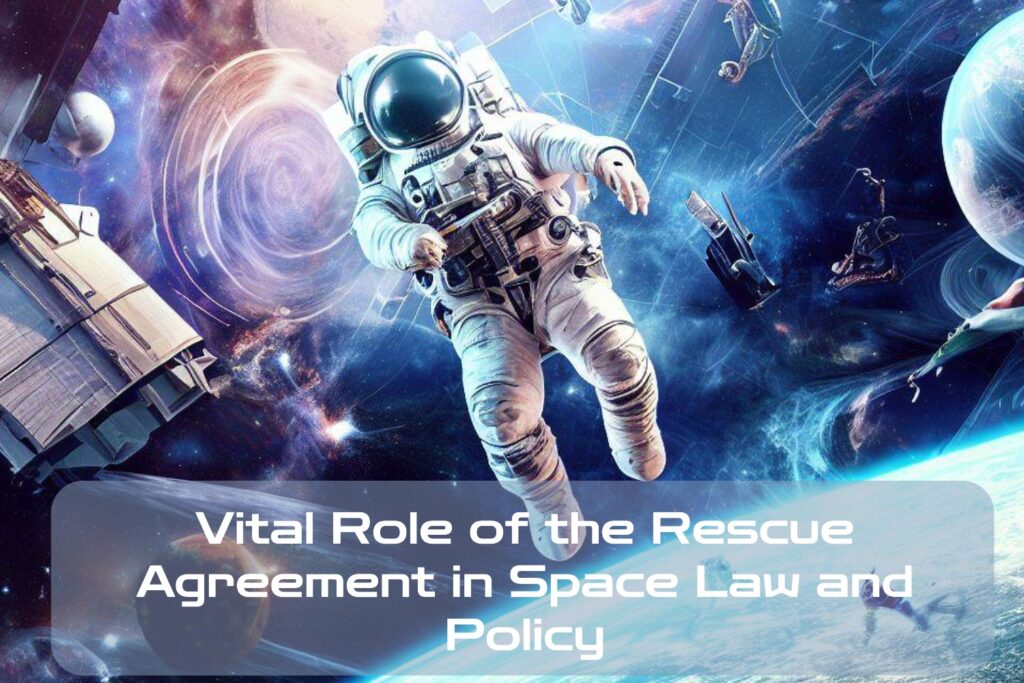Why we need space law and policy
Space exploration has come a long way since the first satellite, Sputnik 1, was launched into orbit by the Soviet Union in 1957. Since then, humans have landed on the Moon, and sent spacecraft to explore every planet in our solar system.
With private companies also getting involved in space exploration, it has become increasingly important to have laws and policies governing activities in space. Space law and policy help ensure safety, prevent conflicts, and promote cooperation between countries.

Just like we have traffic laws on Earth to keep drivers safe and prevent accidents, we need rules for activities in space. Without them, there could be collisions between satellites or other spacecraft that could endanger lives or cause damage.
The Rescue Agreement: What is it?
One of the most important international agreements related to space is the Rescue Agreement. This agreement was created by the United Nations General Assembly in 1968 following the launch of the first human-crewed mission by Russia (then the USSR), Voskhod 1.

The purpose of this agreement is to ensure that astronauts who are in distress are rescued quickly and safely. It also outlines guidelines for providing assistance to spacecraft that are not manned by astronauts but require help due to technical issues or other emergencies.
The Rescue Agreement is one of five international treaties related to space law adopted by the United Nations General Assembly. Its importance cannot be overstated, as it lays out fundamental principles for cooperation between countries when it comes to human lives at risk beyond our planet’s atmosphere.
Importance of discussing The Rescue Agreement
In recent years, as private companies such as SpaceX enter into the field of space exploration with ambitious plans for lunar travel, interplanetary colonization missions, etc., discussions around these treaties have been revived. There has been growing debate around whether these agreements are still effective in dealing with the new age of space exploration. It is important to discuss the Rescue Agreement to understand its importance, assess gaps and limitations, and debate how it should evolve in light of the current developments in space technology and activities.
The history of the Rescue Agreement

Background on the Cold War era and the Space Race
The 20th century was a time of intense geopolitical tension between the United States and the Soviet Union, known as the Cold War. The two superpowers were in a race to outdo each other in every area imaginable, including space exploration. The launch of Sputnik by Russia in 1957 was a major wake-up call for the US, and they quickly ramped up their own efforts to catch up with their adversary.
This competition between nations was not just about bragging rights or technological superiority; it was also about control over strategic resources that could be used in warfare. Winning the space race would mean gaining access to valuable communication satellites, as well as having an advantage in intelligence gathering and military technology.
Creation and adoption of the Rescue Agreement in 1968
With so much at stake, it became clear that there needed to be some basic rules for how nations would behave in outer space. In 1968, the United Nations General Assembly adopted what is now known as the Rescue Agreement, which outlines guidelines for how astronauts should be rescued if they become stranded or injured while on missions beyond Earth’s atmosphere.
The agreement requires signatory nations to take all possible measures to rescue astronauts who are in distress and to provide assistance to spacecraft that are experiencing difficulties. It also mandates that any astronaut who is rescued must be returned safely to their country of origin.
Today, more than 100 countries have signed onto this crucial agreement, making it one of the most widely accepted international treaties related to space exploration. Its creation marked an important milestone in human history: we had finally recognized that our adventures beyond Earth’s atmosphere needed some basic ground rules if we were going to engage in safe and productive exploration together.
Key provisions of the Rescue Agreement

Obligation to rescue astronauts in distress
One of the most important provisions of the Rescue Agreement is the obligation to rescue astronauts in distress. This means that if an astronaut is stranded or injured in space, all other countries that are signatories to the agreement are required to make their best efforts to rescue them. This provision has been crucial in ensuring the safety of astronauts, as it ensures that there is a coordinated effort among nations to aid those in need.
For example, when the Apollo 13 mission experienced an explosion on board that put its crew in danger, NASA and other countries worked together to ensure their safe return. This collaboration was possible thanks to the Rescue Agreement and its provisions for mutual assistance.
Responsibility for providing assistance to spacecraft in distress
In addition to rescuing astronauts, another key provision of the Rescue Agreement requires signatories to provide assistance to spacecraft that encounter difficulties while in space. This covers situations such as malfunctions or collisions with debris or other objects. The obligation extends beyond just human-crewed missions; it also includes unmanned probes and satellites.
This provision is important because it ensures that all countries have access to support when conducting space missions. It also helps prevent any potential conflicts or misunderstandings between nations during such situations by committing them ahead of time.
Return of astronauts and spacecraft
The final main provision of the Rescue Agreement is regarding returning astronauts and spacecraft back home after a mission. Signatory countries are required to facilitate this process by allowing for entry into their territories and coordinating transport arrangements once they are back on Earth.
This provision helps ensure accountability for all countries involved as well as a smooth transition after a mission ends. It also helps avoid potential legal disputes over jurisdiction by establishing clear procedures ahead of time.
Overall, these three key provisions of the Rescue Agreement have been essential in promoting cooperation and safety in space exploration. By establishing clear guidelines for mutual assistance, it has helped prevent potential conflicts between countries while ensuring that all astronauts and spacecraft receive the help they need when in distress.
Impact on space exploration missions

The Rescue Agreement has had a significant impact on space exploration missions since its adoption in 1968. One of the most important provisions of the agreement is the obligation to rescue astronauts in distress, which has helped save lives during some of the most dangerous moments in space history. For example, during the Apollo 13 mission in 1970, an explosion crippled the spacecraft and put the lives of the three astronauts onboard in grave danger.
Thanks to a coordinated international effort involving NASA, Soviet Union authorities, and other nations such as Canada and France, all three astronauts were safely returned to Earth. This successful rescue mission would not have been possible without the provisions established by the Rescue Agreement.
In addition to saving lives, the Rescue Agreement has also played a crucial role in promoting international cooperation in space exploration. By establishing clear guidelines for how countries should assist each other during emergencies, this agreement has helped foster goodwill between nations and encourage collaboration on future missions.
Examples of successful rescues under the agreement
Over the years, there have been many successful rescues under the Rescue Agreement. One particularly noteworthy example occurred during an unmanned Soyuz spacecraft mission in 1975.
A malfunction caused an explosion that separated one module from another while it was docked with another station; as a result, both modules lost orientation control systems and could not point their solar arrays toward the Sun, keeping them unable to generate power for their batteries that were draining quickly. This made communication with Earth impossible for several hours.
With time running out before their oxygen supply depleted completely within hours; US astronauts Stafford and Slayton who were working at NASA’s Mission Control Center, joined forces with their Soviet counterparts to develop a plan for reestablishing communications via ground stations using radio signals sent from Earth-based antennas due to the absence of functioning antennae on board. They also agreed upon a stabilization plan that would allow both modules to receive enough sunlight on their solar panels, enabling them to generate enough power to keep the crew alive. Thanks to the cooperation and ingenuity of all involved, the Soyuz astronauts were rescued and safely returned to Earth.
Role in promoting international cooperation in space exploration
In addition to its role in emergency situations, the Rescue Agreement has helped promote international cooperation in space exploration by establishing clear guidelines for collaboration. By establishing procedures for sharing information and resources during emergencies, this agreement has helped countries work together more effectively toward common goals.
For example, during the International Space Station (ISS) project, which involves 16 participating nations, the Rescue Agreement has been instrumental in providing a framework for cooperation between countries. By outlining how astronauts should be rescued and returned home after an emergency situation on board the ISS, this agreement has facilitated better communication and coordination between nations.
Overall, it is clear that the Rescue Agreement has been a vital tool in ensuring safety and cooperation in space exploration missions. As technology continues to advance and new challenges arise, it will be important for nations to continue working together under this agreement so that future missions can be completed successfully.
Challenges and limitations

As with any international agreement, the Rescue Agreement is not without its challenges and limitations. One of the most significant issues is the lack of enforcement mechanisms. While countries are obligated to comply with the provisions of the agreement, there are no specific penalties or consequences for failure to do so.
This means that, in some cases, countries may choose to prioritize their own interests over those of other spacefaring nations. Another challenge is the interpretation of certain provisions.
One example is Article 5, which establishes that states must provide assistance to spacecraft in distress “to the greatest extent feasible.” The phrase “greatest extent feasible” leaves room for interpretation, and different countries may have varying opinions on what level of assistance is reasonable or necessary in a given situation. This can lead to disputes between countries and potential delays in providing aid.
Lack of enforcement mechanisms
The lack of enforcement mechanisms within the Rescue Agreement has been a point of criticism since its adoption in 1968. Some experts argue that without specific penalties for noncompliance, some countries may be more likely to ignore their obligations under the agreement when it is not convenient for them to do so.
Additionally, even if a country violates the terms of the agreement, there are no clear procedures for resolving disputes or holding nations accountable. However, other experts argue that creating strict enforcement mechanisms could actually undermine cooperation between nations in space exploration efforts.
Imposing penalties or punishments could lead to a “tit-for-tat” mentality where each country prioritizes its own interests over those of others. Ultimately, striking a balance between accountability and cooperation will be key when addressing this challenge.
Interpretation issues with certain provisions
Another challenge posed by the Rescue Agreement is interpretation of certain provisions. As mentioned previously, Article 5’s language regarding providing assistance “to the greatest extent feasible” is somewhat vague and open to interpretation.
Additionally, other provisions may be subject to different interpretations depending on a country’s specific legal system or cultural norms. Addressing these interpretation issues may require additional guidance or clarification from the international community.
Experts have suggested creating a “best practices” guide for interpreting and implementing the Rescue Agreement, similar to those used in other areas of law. This could help ensure that all countries are approaching the agreement in a consistent and cooperative manner.
Future Implications for Space Law and Policy

As space exploration continues to evolve, it is important for space law and policy to adapt as well. The Rescue Agreement has been a vital component in ensuring the safety of astronauts and spacecraft, but there are still many challenges that need to be addressed. One area of concern is the lack of clear enforcement mechanisms in the agreement.
This makes it difficult to hold countries accountable if they fail to comply with their obligations under the agreement. Another challenge is related to the interpretation of certain provisions in the agreement.
For example, there may be some ambiguity around what constitutes a “distressed spacecraft” or what level of assistance is required by other countries in providing aid. These issues will need to be addressed as space exploration becomes more complex and diverse.
Potential Updates or Revisions
To address these challenges, there have been calls for updates or revisions to the Rescue Agreement. Some experts have suggested that clearer guidelines are needed on how countries should respond when a spacecraft or astronaut is in distress. There may also be a need for more formalized procedures for cooperation between countries during rescue missions.
Another area where revisions may be necessary is related to commercial ventures in space exploration. With companies like SpaceX and Blue Origin making significant strides in this field, there needs to be greater clarity around how commercial entities fit into existing space law and policy frameworks.
The Importance for Future Missions
The Rescue Agreement will continue to play an important role in ensuring safety and cooperation during future missions, including those involving commercial entities. As private companies increasingly enter this field, it will become even more critical for international cooperation frameworks like the Rescue Agreement.
Moreover, as we look towards ambitious goals like human missions to Mars, it becomes even more important that we have clear guidelines on how different countries will work together towards common goals while also respecting each other’s sovereignty. Through the continued evolution of space law and policy, we can ensure that future space exploration missions are carried out safely, collaboratively, and with the best interests of all nations in mind.
Going Forward

After examining the history, key provisions, impact, challenges, and limitations of the Rescue Agreement, it is clear that this international treaty has significant importance for ensuring safety and cooperation in space exploration. The Rescue Agreement is a critical component of space law and policy as it serves to protect astronauts and spacecraft during missions, while promoting international collaboration.
The Rescue Agreement was created during a time of intense global competition between superpowers. However, over the years, its provisions have been used for successful rescues and emergency situations.
This highlights the importance of international agreements in promoting cooperation and peaceful relationships between nations. Despite its strengths, there are still some challenges to be addressed with the Rescue Agreement.
One example is the lack of enforcement mechanisms, which can make it difficult to ensure compliance with certain provisions. However, efforts are being made to address these issues through discussions among countries involved in space exploration.
Looking towards future missions, including commercial ventures in space tourism or mining operations on celestial bodies such as asteroids or moons, will require updates to existing agreements or new ones entirely. The Rescue Agreement will play an important role in ensuring safety for these missions as well.
Ultimately, the Rescue Agreement serves as an important reminder that space exploration is not just about technological advancement but also about fostering cooperation between nations for peaceful purposes. As we continue to explore beyond our planet’s confines, we must remember that our mutual successes will depend on our ability to work together towards common goals rather than against each other.
FAQs
– What is the Rescue Agreement?
– The Rescue Agreement is an international treaty created by the United Nations General Assembly in 1968. It aims to ensure the quick and safe rescue of astronauts in distress and provides guidelines for providing assistance to spacecraft facing technical issues or emergencies.
– Why do we need space law and policy?
– Space law and policy are necessary to govern activities in space and ensure safety, prevent conflicts, and promote cooperation between countries. They are similar to traffic laws on Earth, helping to prevent accidents and collisions between satellites or spacecraft.
– How does the Rescue Agreement promote cooperation between countries?
– The Rescue Agreement establishes principles for cooperation between countries when it comes to the safety of astronauts beyond Earth’s atmosphere. It mandates that signatory nations must make their best efforts to rescue astronauts in distress and provide assistance to spacecraft facing difficulties, fostering international collaboration and mutual support.
– What are the key provisions of the Rescue Agreement?
– The key provisions of the Rescue Agreement include the obligation to rescue astronauts in distress, the responsibility to provide assistance to spacecraft in distress, and the requirement for the return of astronauts and spacecraft after a mission. These provisions ensure the safety and accountability of all countries involved in space exploration.
– How has the Rescue Agreement impacted space exploration missions?
– The Rescue Agreement has had a significant impact on space exploration missions. It has helped save lives by ensuring the rescue of astronauts in distress, such as during the Apollo 13 mission. It has also promoted international cooperation by providing guidelines for collaboration during emergencies, fostering goodwill and coordination among nations.
– What are the challenges and limitations of the Rescue Agreement?
– One challenge is the lack of enforcement mechanisms within the agreement, which may lead to noncompliance by some countries. Another challenge is the interpretation of certain provisions, which can vary among nations. These challenges call for further discussions and potential revisions to address accountability and ensure consistent implementation.
– What are the future implications for space law and policy?
– As space exploration continues to evolve, space law and policy, including the Rescue Agreement, need to adapt. Updates or revisions may be necessary to address challenges such as enforcement mechanisms and interpretation issues. Clearer guidelines for distress situations and cooperation in commercial ventures are also needed to accommodate the changing landscape of space exploration.
– Why is the Rescue Agreement important for future missions?
– The Rescue Agreement will continue to be important for ensuring safety and cooperation in future missions, including those involving commercial entities. It provides a framework for international collaboration, clarifies responsibilities, and promotes mutual assistance. By evolving space law and policy, we can ensure that future missions are conducted safely and with the best interests of all nations in mind.
TL;DR
– 🚀 The Rescue Agreement is an international treaty created by the United Nations General Assembly in 1968.
– 🌍 Space law and policy are essential to govern activities in space, ensure safety, prevent conflicts, and promote cooperation between countries.
– 🛡️ The Rescue Agreement plays a vital role in the safety and rescue of astronauts in distress and provides guidelines for assisting spacecraft facing technical issues or emergencies.
– 🤝 The agreement promotes international cooperation by establishing principles for mutual support and collaboration among signatory nations.
– 🌌 The key provisions of the Rescue Agreement include the obligation to rescue astronauts in distress, the responsibility to provide assistance to spacecraft in distress, and the requirement for the return of astronauts and spacecraft after a mission.
– 💪 The Rescue Agreement has had a significant impact on space exploration missions, saving lives during critical situations such as the Apollo 13 mission and fostering international cooperation.
– 🌟 There have been successful rescues under the Rescue Agreement, including the 1975 Soyuz spacecraft mission where a coordinated international effort led to the safe return of the astronauts.
– 💡 Challenges of the Rescue Agreement include the lack of enforcement mechanisms and interpretation issues with certain provisions.
– 🌐 Updates or revisions may be necessary to address these challenges and ensure accountability and consistency in implementation.
– 🚀 The Rescue Agreement will continue to be crucial for future missions, including those involving commercial entities, as it provides a framework for cooperation and safety in space exploration.
– 🌌 The evolving nature of space exploration calls for adaptations in space law and policy to accommodate changing technologies and activities while prioritizing safety and collaboration.

C M, a seasoned editor, journalist, and consultant, is deeply fascinated by the convergence of technology, space, and the future of humanity.
With a particular interest in transhumanity, futurology, and the philosophical and ethical dimensions of these domains, C M serves as the lead contributor to SpaceSpotlight and TranscendSphere.
When not penning insightful articles on these rapidly evolving fields, C M indulges in their love for podcasts and books, proudly embracing their status as a ‘Happy Nerd Extraordinaire!’



